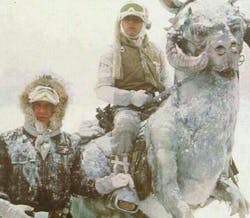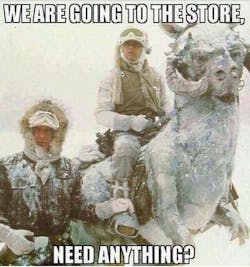Notes from ground-zero of the Great Northeast Blizzard of 2015
We still have power (for the moment), plenty of wood for the fireplace, and a peaceful, quiet content runs through the house -- even with my three-year-old grandson locked and loaded for action at any minute. I thought it would be worse than this, but I shouldn't tempt the fates.
There's about 14 inches of snow on the ground, and what's falling is coming down sideways as the noreaster wind brings it in off the Atlantic. In my neighborhood it's 16 degrees outside, and the winds are coming pretty much from straight north blowing at 10 miles per hour, gusting to 25. It could be worse later.
I grew up in Southern California, where snow is something you have to travel to if you're interested in any kinds of winter sports. Most of the time I was happy to see the snow in the distance on the crest of the San Gabriel Mountains. Believe it or not, there's a 10,068-foot peak in Los Angeles County, but I digress.
Instead of "going to the snow," it was just as easy to enjoy the 70-degree winter weather down by the South Bay beaches and watch snow storms happening elsewhere on television.
Not so now. As a relative newcomer to New England (I've only been here a scant 20 years), I still have a vague sense of an outsider looking in. I wasn't here for the Blizzard of '78, so it's openly acknowledged that I've never seen a real snow storm.
Winter weather represents a cultural phenomenon here. There are obligatory pre-storm adrenalin-charged last-minute trips to the grocery store for bread, milk, and eggs -- whether you need them or not. We check and stockpile battery supplies, bring in firewood, check gasoline supplies, and fire-up generators and snow blowers just to make sure.
Storm talk dominates water-cooler conversation, and inevitably the worst-case and most wildly inaccurate weather forecasts picked up from obscure Websites and backwater radio stations are taken as gospel. A forecast for 14 inches of snow quickly becomes four feet. Anticipated 30-mile-per-hour wind gusts become Category-5 hurricanes.
I think we indulge in this hyperbole because it's fun. Let's face it, how often is it really exciting to talk about the weather? We like to congratulate ourselves for facing down another "historic" storm that we'll tell our grandchildren about. By that time our recollections of the storm will be about as accurate as the pre-storm forecasts.
After the last snow flakes fall, how on Earth will we recover?
Here in New Hampshire we'll plow out, dig out, and go about our business. By the end of the week we'll already be looking forward to the next "historic" winter storm.
And for the time being, let it snow. Just, please don't knock out the power.
Postscript: The "historic" Northeast Blizzard of 2015 has come and gone. We got about 14 inches of light, fluffy snow, which isn't out of the ordinary for any sizable winter storm. We're all dug out and back to normal. It was worse south of us in Massachusetts where I've seen reports of 27 to 32 inches of snow. We stayed warm during the storm and, thankfully, never lost power
I have a feeling the weather forecasters may have gotten swept up somewhat in the pre-blizzard drama. Anyway, it's over now and we're looking forward to the next forecast snow by the end of the week.
And so it goes ...

